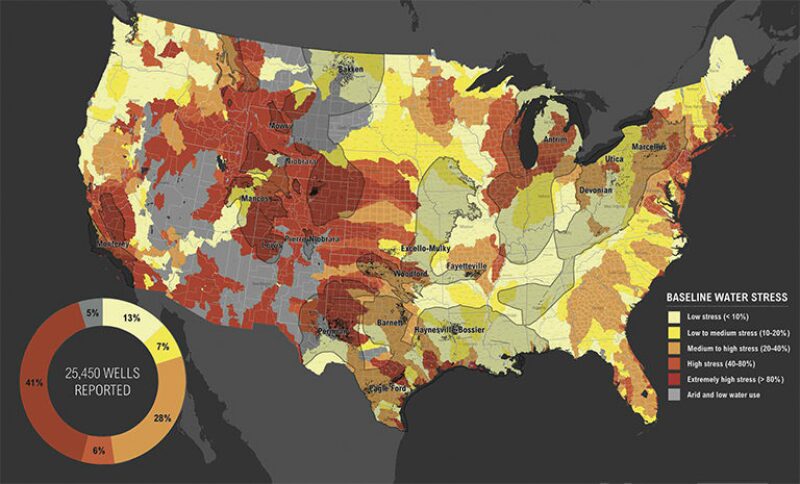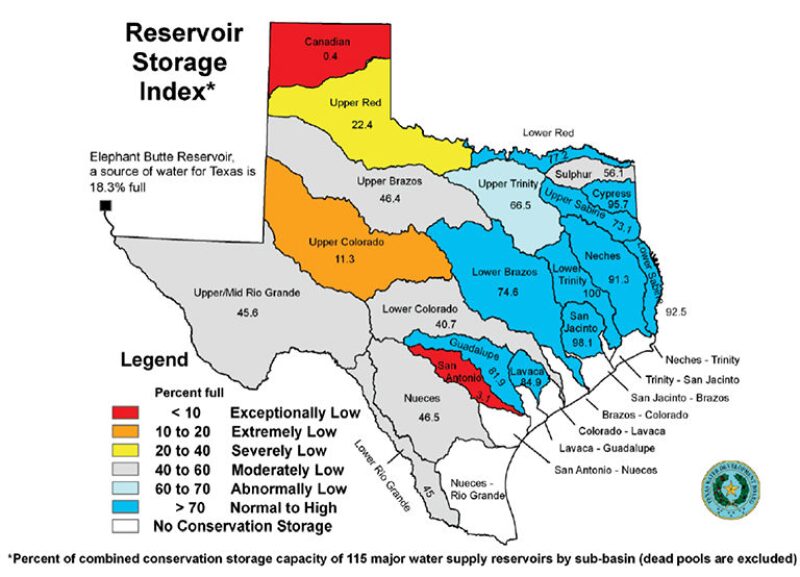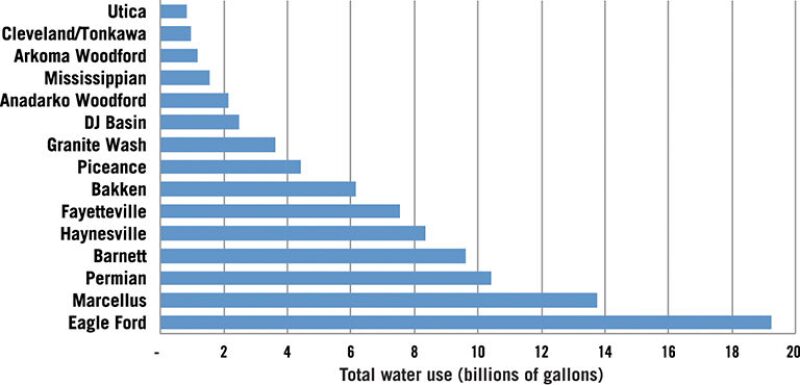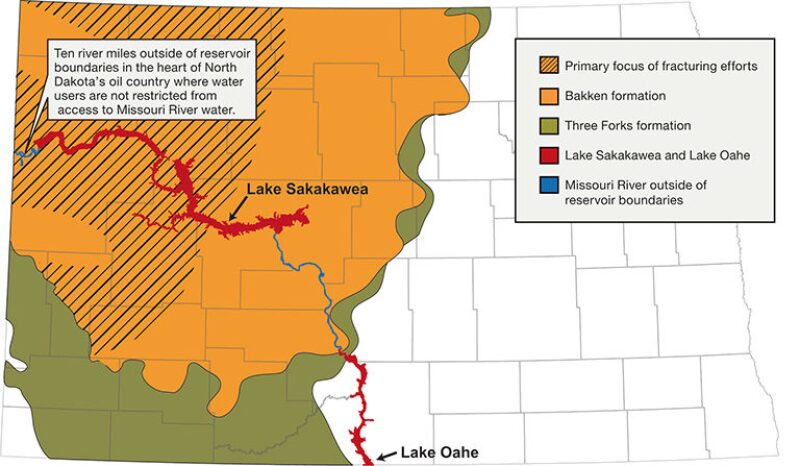It is common knowledge that hydraulic fracturing operations require a lot of water, and as they have become a more vital element of the oil and gas industry, sourcing this water has proven to be a challenge for companies operating in tough terrain.
Drought plagues much of the United States, a country with significant hydraulic fracturing activity, and operators have to take hydrology concerns into consideration when constructing facilities in these environments. In most cases, the solution means recycling produced and flowback water and diminishing, or eliminating altogether, the need for fresh water.
Depending on the region and its specific challenges, operators are finding unique ways to address the water issue. In the past couple of years, new facilities have been built or repurposed with new technologies that may affect how companies work in water-stressed shale plays in the future.
Where are these new facilities with these new technologies, and how will they help operators solve the problem of finding water to use in an expanding sector of the industry?
Hydrology
The competition for water from users in fracturing and other users is high. According to Ceres, a nonprofit organization that focuses on water scarcity, 41% of wells in the US are in regions with extreme water stress, or areas where more than 80% of available water is being drawn by municipal, agricultural, and industrial users. Although hydraulic fracturing usually accounts for less than 2% of a state’s overall water usage, the figure can be much higher in some locations (Freyman and Salmon 2013).
Sahar Mouallem, a product line manager of water management at Baker Hughes, said that dry conditions have a clear effect on the construction of treatment facilities.
“The treatment facility would have to be equipped to handle produced, flowback, or alternate sources of water for reuse as opposed to pretreating fresh water only. The type of treatment facility depends on several factors like the size of the project, volumes of water to be handled, transportation, and transfer methods as well as the space available. This is a highly mobile business that requires rapid response and small footprint solutions,” she said.
Fig. 1 illustrates the geological breakdown of the competition for water. Shale plays in areas experiencing the highest water stress are located in drier regions, or regions experiencing droughtlike conditions, for example, in the western US: west and central Texas (e.g., Permian and Eagle Ford) and California (e.g., Monterey). Water costs in drier regions are higher as a result.

Without factoring the cost of transportation, the typical cost of water at the sources in the Eagle Ford and Barnett shales is between 25% and 35% higher per barrel than in water-rich regions. In the Bakken and Denver-Julesburg Basin, where shale plays experience dry conditions in the summer, the transportation cost rises by between 50% and 100% (Slutz et al. 2012). Facing such numbers, companies are doing their best to limit the use of fresh water.
Freyman said that the use of recycled water has increased, as has the use of other sources such as waste water, saline water, and seawater. While recycling rates in many regions are still in the single digits percentagewise, some areas have reached a rate as high as 40%. Some parts of Texas have seen a spike in saline water use. However, Freyman argued that these figures are insufficient to make a significant effect on the amount of fresh water used.
Mouallem said the industry could reach a point at which operators do not use any fresh water for hydraulic fracturing operations in certain locations.
“We certainly hope so,” she said. “The industry is getting smarter and is developing technologies and solutions that enable operators to recycle produced and flowback water, or use alternate sources of water in their operations. Many are implementing water management plans to transition from fresh water to other sources and mitigate any of the risks and costs associated with that. There, however, will be exceptions as local conditions and a matrix of variables will dictate the feasibility and economics of using alternate sources of water, even recycling.”
In the eastern US, hydrology issues are not severe, as there are plentiful sources of fresh water and operators can acquire it at a relatively small cost. However, in the western US, many shale plays have been drought-stricken for lengthy periods of time, thus requiring operators to look for alternative methods of sourcing and to emphasize their recycling efforts.
Regardless of the methods used, Mouallem said recycling is not a cure-all for water sourcing problems.
“Recycling and reuse of produced and flowback water for hydraulic fracturing operations addresses many, but not all, water sourcing challenges,” she said. “There are many areas that have low volumes of produced and flowback water, which lowers the potential for recycling. Taking that fact into account, alternate sources of water are being tapped as well to solve these problems.”
Eagle Ford
Severe drought has crippled the Eagle Ford, a play where capital expenditure for shale energy development continued at an accelerated pace for the past few years and was expected to reach USD 30 billion this year (Freyman 2014). It takes 80,000 to150,000 bbl of water to fracture a single well.
Much of the area, particularly around San Antonio, rates between moderately low and exceptionally low on the Texas Water Development Bureau’s reservoir storage index. The index is a percentage of combined conservation storage capacity of 115 major water supply reservoirs in a designated region (Fig. 2). And the competition for water is as fierce as ever: From January 2011 to May 2013, wells in the region used 19.2 billion gal of water, the highest usage of any region in the US (Fig. 3).


Saline aquifers account for 20% of overall water usage in hydraulic fracturing operations in the Eagle Ford. Within 5 years, operators may be recycling half of the waste water produced as drought conditions force them to take aggressive measures, thanks in large part to more flexible regulations recently approved by the Texas Railroad Commission.
Disposal wells are more plentiful in the Eagle Ford than in other low-water shale plays, particularly along the coast of the US Gulf of Mexico and in the middle of the play, and they are at the lower end of the cost spectrum (Slutz et al. 2012). However, this has not stopped operators from looking for opportunities to increase their recycled waste water.
Wastewater recycling units have been in use since 2011. Companies have increased their efforts to recycle in the following years, and some of those efforts have already borne fruit. In 2013, Marathon, which owned approximately 211,000 net acres of land in the Eagle Ford and spent USD 2.4 billion in the region that year, invested USD 10 million on 5 miles of pipelines, pond expansions, water supply well upgrades, and brackish water supply wells to transport and manage water more effectively.
A central element of this plan was a pilot water treatment unit called the HIPPO (hydro innovation purification platform for oil and gas), created by Omni, a water treatment technology company based in Austin, Texas. The firm aims to reduce boron levels from 90 ppm to less than 5 ppm in the freshwater stream, which makes it compatible with gel fracture formulations and able to be reused in future well operations without the need for more fresh water (Omni 2013).

The unit has a real-time sense-and-respond automation system that allows operators to treat waste water at a lower cost and with more consistent results. The HIPPO unit treated more than 140,000 bbl of water in its first 3 months of operation. After running the unit for more than a year, Marathon said it recovered approximately 130,000 bbl for reuse (Marathon 2013a).
In 2014, Marathon intended to use alternative sources for at least 50% of its water needs in the Eagle Ford. The company estimated that these sources would allow them to reuse approximately 65% of the treated water stream.
Last May, Nuverra, an environmental services company, purchased 180 acres in LaSalle County in south Texas, approximately 100 miles southwest of San Antonio. LaSalle is one of three counties in the Eagle Ford, along with Dimmitt and Zavala counties, in which local aquifer levels have declined by between 100 ft and 300 ft (Freyman 2014). Slated to open in the first quarter of next year, this facility will be similar to one that the company is building in the Bakken. That facility will use heat to treat waste water.
Permian Basin
Of all the major shale plays in the US, the Permian Basin faces perhaps the most drought difficulty. According to Ceres, more than 70% of the play’s wells are in areas of extreme water stress, as the basin overlaps parts of the depleted Ogallala aquifer (Freyman 2014). While Permian wells use less water on average than wells in the Eagle Ford, the sheer number of wells in the region—more than 9,300 have been in development since 2011—means that the competition for water is much higher.
Since the Permian produces high levels of flowback water and its produced water has a low salinity, operators there are taking steps to increase water recycling.
Pioneer, one of the companies working in the Permian, has made significant strides with its water recycling efforts as it increases its production there. The company operates about 825,000 gross acres and 432 million BOE of proved reserves in the play, with the Spraberry and Wolfcamp shales representing the primary focus of its operations. In the third quarter of 2013, the company partnered with Fountain Quail to set up its Nomad recycling units at its wastewater disposal well near Midkiff, a small town approximately 60 miles southwest of Odessa in west Texas (Sakelaris 2013). The units convert from 3,000 to 5,000 bbl of waste water per day (Pioneer 2014a).
This year, Pioneer teamed with Gradient to commercialize a new process at a modular water treatment plant in Midland that could make recycling efforts easier across the board. Called carrier gas extraction (CGE), the process was developed at the Massachusetts Institute of Technology.

It starts with water being pretreated to remove oil and grease residue as well as solid particles. The saline water is then heated and sprayed into a porous material, thus saturating the air with water vapor. That air is then pumped into shallow, water-filled trays through a series of holes, and as bubbles pass through that water, the water vapor in the bubbles condenses and joins the water it is passing through. This creates the fresh water needed to perform future hydraulic fracturing operations (Talbot 2014).
The process is similar to a traditional humidification dehumidification desalination setup, but it will require significantly less energy (Chandler 2013). The Midland plant is capable of treating 500,000 gal/D.
CGE was named the “Industrial Water Project of the Year” by the Global Water Intelligence for advancing water recycling efforts the furthest within a year’s time (Pioneer 2014b).
Elsewhere in Texas, Apache, another major driller in the Permian Basin, has conducted its own in-house water revolution out of a former hunting lodge near Barnhart, where the company has about 38,000 contiguous acres of land. The small town has been hit particularly hard since the onset of drought in 2011. Its water tower went dry in June 2013 and despite the construction of a new well this past summer, the water shortage in the area is still significant.

The Barnhart facility recycles 100% of its produced water, thanks to a process in which brackish water is pumped from the Santa Rosa aquifer into a large pond with a 500,000-bbl capacity. At the same time, a system of pipes takes the produced and flowback water from wellsites to a set of storage tanks in which it is treated to remove iron and other minerals. Water from both sources is piped back to a wellsite, where it can be used for future hydraulic fracturing jobs. When it is pumped downhole, the water gets treated with chemical agents to kill bacteria (Apache 2014).
Bakken
Compared with the big shale plays in Texas, the Bakken in North Dakota is a fairly wet region. In their report, Freyman and Salmon did not list it as an area of high water stress, and with roughly half the number of rigs in operation as the Permian and fewer rigs than the Eagle Ford, the competition within the industry is not as extreme. But the challenges are still significant for operators in the region.
North Dakota is prone to droughts and floods, but more than weather concerns, the biggest threats to water availability are increased competition and government restrictions. The Missouri River system accounts for approximately 96% of the water flow from rivers and streams in the state. In recent years, the US Army Corps of Engineers has denied access to operators beyond previously established allotments under its surplus water policy.
Under the Flood Control Act of 1944, the corps has the authority to charge fees for the use of surplus water, or water that was made available because of authorized project uses that were never fully developed, in the main reservoirs. The corps has restricted access to the Missouri River flows within the boundaries of Lake Sakakawea and Lake Oahe, leaving just 10 miles of the river accessible to industrial water users (Fig. 4).

In addition, the level of activity in the region will only get higher in the coming years. Oil output in the Bakken has more than doubled since August 2011, and the North Dakota State Water Commission estimated that it will see approximately 2,500 new wells per year for the next 15 to 25 years. The average fracture treatment in the Williston Basin has increased from approximately 15,000 bbl in 2008 to 60,000 bbl in 2013 (Griffin et al. 2014). With competition growing and production expected to increase, operators have been forced to look at other sources.
The first significant pilot test of recycling water in the Bakken was not approved until December 2013, when the North Dakota Industrial Commission gave the green light to Statoil’s plan to test produced water at a wellsite north of Williston (Dairymple 2013). The approval did not come easily. Statoil first had to do a small-scale test to determine if produced water could be used for fracturing because of the high salinity content of water in the Bakken. The company then had to outline how it would store the approximately 3 million gal of produced water needed to execute its hydraulic fracturing operations on location.
With a river located a mile away from the test site, Statoil carried out extra safety precautions to help guard against a spill of produced water. The facility was designed with three double-walled tanks, each capable of holding more than 1 million gal. The tanks were nested to prevent a spill; if one tank ruptured, the second could hold the remaining water. A large berm, or raised barrier, surrounded the area as a last line of defense. The company was required to have the material and earth-moving equipment needed on site to build a dike in a worst-case scenario.
In accordance with North Dakota’s storage and containment requirements, the test was performed in two locations: one for water storage and the other for staged fracturing operations. Returned bywater was transferred through a freshwater pipeline connecting the two locations; this required the shut-in of a section of the freshwater pipeline. For this reason, the company had to ensure continued freshwater service to the affected operational areas by other means (Statoil 2014).
Building on its work in the Eagle Ford, Marathon is also looking to conserve water in the Bakken. The company is looking to mitigate the high salt content in produced water with polymer gels and exploring a proprietary treatment process to get clean, reusable brine for drilling and fresh water for hydraulic fracturing (Marathon 2013b).
A Smaller Play
In central Oklahoma, the Cana-Woodford play is not as big as its neighbors to the south. For Devon, the play still represents an opportunity. The play has been in the midst of a revival this past year, with initial 30‑day production up 35% in the second quarter and the company planning to add more rigs next year.
Devon said it decided to look into reusing water shortly after it began drilling its first wells in the play in 2008. The company realized that the flowback water was of an exceptional quality due to its very low salt content of about 20,000 ppm. By comparison, the Barnett Shale’s flowback water contains up to 60,000 ppm, forcing operators to distill the water before reusing. Water in the Cana-Woodford does not require extensive filtration for reuse (Devon 2014).
The water reuse facility is located halfway between Geary and Calumet, approximately 50 miles northwest of Oklahoma City. It contains a 500,000‑bbl storage reservoir and a series of pipelines that connect to various wellsites in the region. Since the reservoir was 10 times larger than the industry standard for water storage, the company worked with the Oklahoma Corporation Commission on creating an adequate set of regulations for it. Ceres rated the play as having high to extremely high water stress.
Construction came at a time of extreme drought in Oklahoma that continues to this day and will likely not end this winter. However, the reuse project allowed Devon to complete its wells in the Cana-Woodford despite the drought. Within its first 9 months of operation, it helped the company save about 200 million gal of water, and since 2013, it has saved an additional 75 million gal (Devon 2014). OGF
For Further Reading
SPE 157532 Key Shale Water Management Strategies: An Economic Assessment Tool by J. Slutz, Global Energy Strategies, et al.
SPE 169497 Technical Implementation and Benefits of Use of Produced Water in Slickwater and Hybrid Treatments in the Bakken Central Basin by L. Griffin, Liberty Resources, et al.
Apache. 2014. Fresh ideas for re-using water in Permian, Central regions. http://www.apachecorp.com/News/Articles/View_Article.aspx?Article.ItemID=3893 (accessed 10 November 2014).
Chandler, D.L. 2013. Purification on the cheap. MIT News (5 February 2013), http://newsoffice.mit.edu/2013/produced-water-cleanup-0205.
Dairymple, A. 2013. New fracking technique could cut demand for fresh water. The Forum of Fargo-Moorhead (21 November 2013), https://secure.forumcomm.com/?publisher_ID=1&article_id=421809&CFID=241375422&
CFTOKEN=12182442.
Devon. 2014. Cana Water Recycling. http://www.devonenergy.com/featured-stories/cana-water-recycling (accessed 4 November 2014).
Freyman, M. 2014. Hydraulic Fracturing & Water Stress: Water Demand by the Numbers. http://www.ceres.org/resources/reports/hydraulic-fracturing-water-stress-water-demand-by-the-numbers/view (accessed 24 October 2014).
Freyman, M. and Salmon, R. 2013. Hydraulic Fracturing & Water Stress: Growing Competitive Pressures for Water. http://www.ceres.org/resources/reports/hydraulic-fracturing-water-stress-growing-competitive-pressures-for-water/view (accessed 21 October 2014).
Gomez, J. 2014. Eagle Ford—Annual Conference Energy & Water. http://www.eaglefordconsortium.org/wp-content/uploads/2014/05/EF-3rd-Conference-JDG042214.pdf (accessed 22 October 2014).
Marathon. 2013a. Case Study: Eagle Ford. http://www.marathonoil.com/Social_Responsibility/Reporting/2013_CSR_Report/Case_Studies/Eagle_Ford_Shale/ (accessed 27 October 2014).
Marathon 2013b. Case Study: Bakken Shale. http://www.marathonoil.com/Social_Responsibility/Reporting/2013_CSR_Report/Case_Studies/Bakken_Shale/ (accessed 6 November 2014).
North Dakota State Water Commission. 2014. Facts about North Dakota Fracking & Water Use, http://www.eia.gov/petroleum/drilling/pdf/dpr-full.pdf (accessed 5 November 2014).
Omni. 2013. Recycle of Produced and Flowback Water in Eagle Ford Shale Texas Picks Up Momentum with Omni Water Solutions and Dow Water & Process Solutions. http://www.omniwatersolutions.com/blog/recycle-of-produced-and-flowback-water-in-eagle-ford-shale-texas-picks-up-momentum-with-omni-water-solutions-and-dow-water-process-solutions/ (accessed 22 October 2014).
Pioneer. 2014a. Water Conservation, http://www.pxd.com/values/sustainability/water (accessed 29 October 2014).
Pioneer. 2014b. Permian Basin, http://www.pxd.com/operations/permian-basin (accessed 29 October 2014).
Sakelaris, N. 2013. Pioneer will start recycling frack water with Fountain Quail (27 June 2013), http://www.bizjournals.com/dallas/news/2013/06/27/pioneer-will-start-recycling-frack.html.
Shaver, R. 2012. Water Management Issues Associated with Bakken Oil Shale Development in Western North Dakota. http://www.mgwa.org/meetings/2012_fall/plenary/shaver.pdf (accessed 5 November 2014).
Statoil. 2014. The key to reducing Bakken shale freshwater needs? http://www.statoil.com/en/ouroperations/explorationprod/shalegas/pages/2014_28may_bakken_pilot.aspx (accessed 6 November 2014).
Talbot, D. 2014. How to Clean the Gas and Oil Industries’ Most Contaminated Water. MIT Technology Review (7 July 2014), http://www.technologyreview.com/news/528586/how-to-clean-the-gas-and-oil-industries-most-contaminated-water/.
United States Energy Information Administration. 2014. Drilling Productivity Report: November 2014. http://www.eia.gov/petroleum/drilling/pdf/dpr-full.pdf (accessed 10 November 2014).

